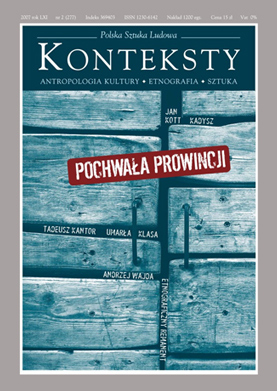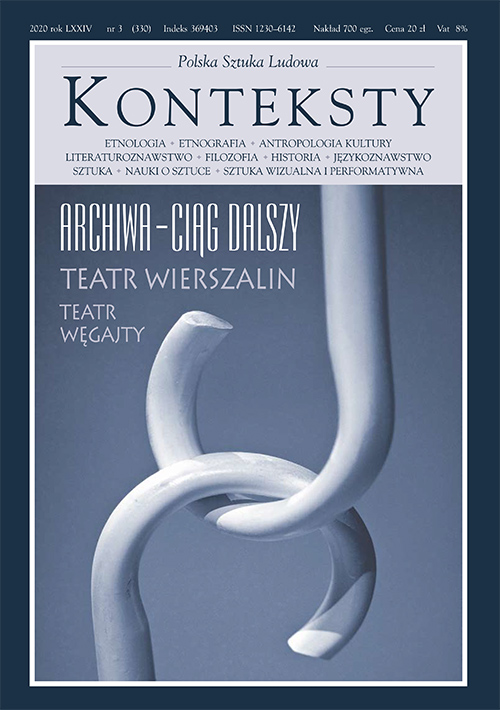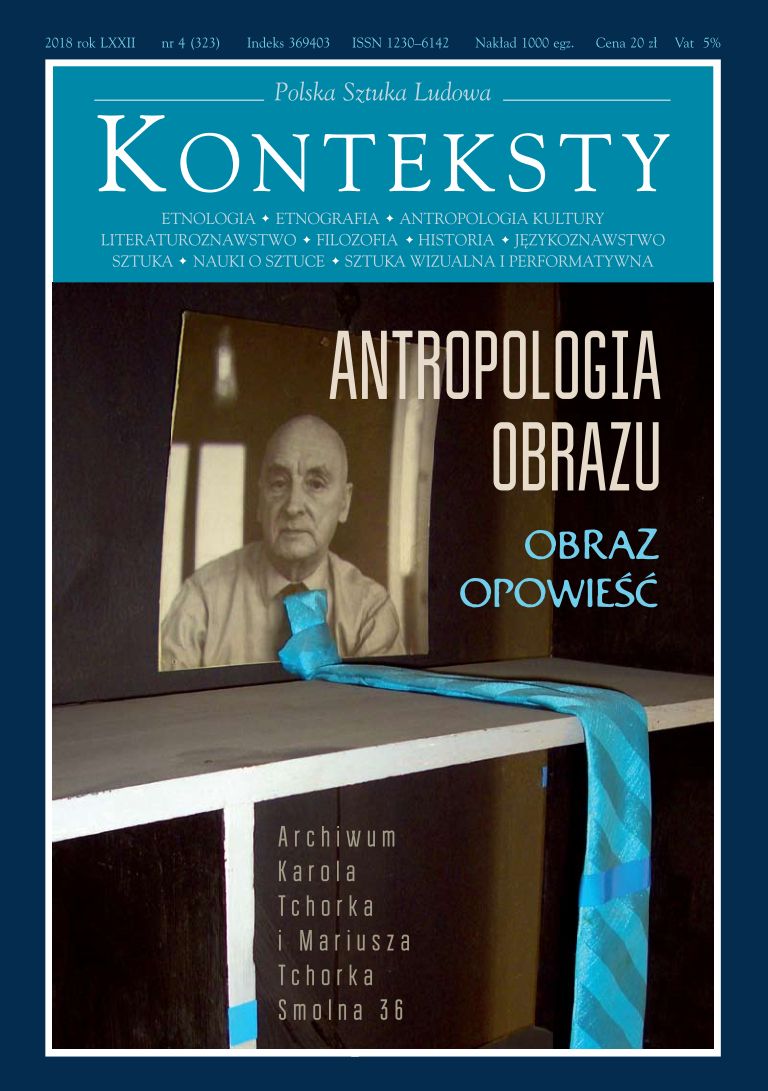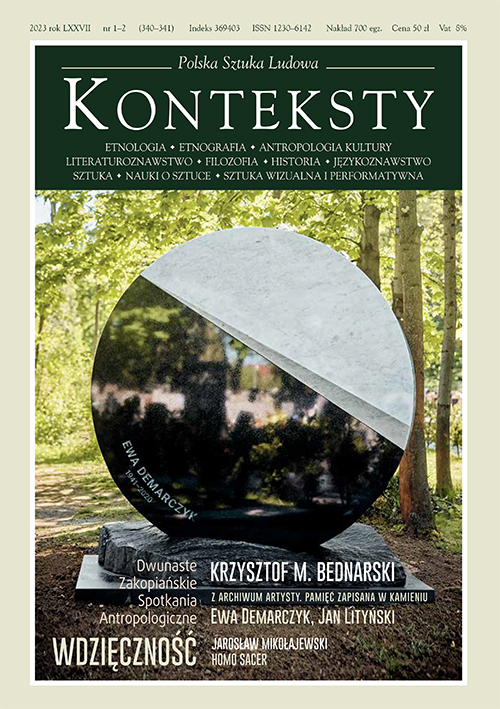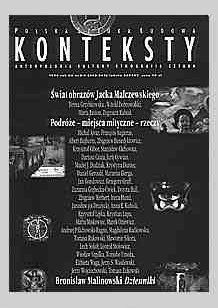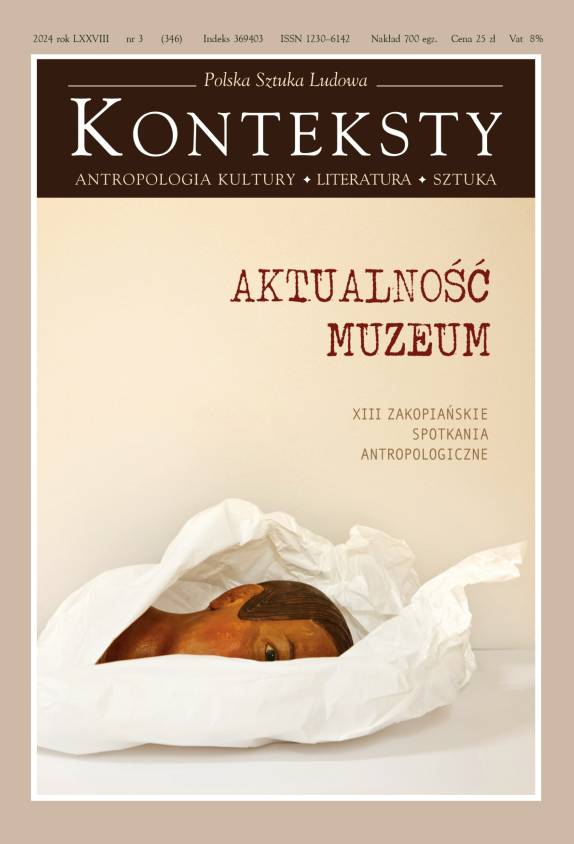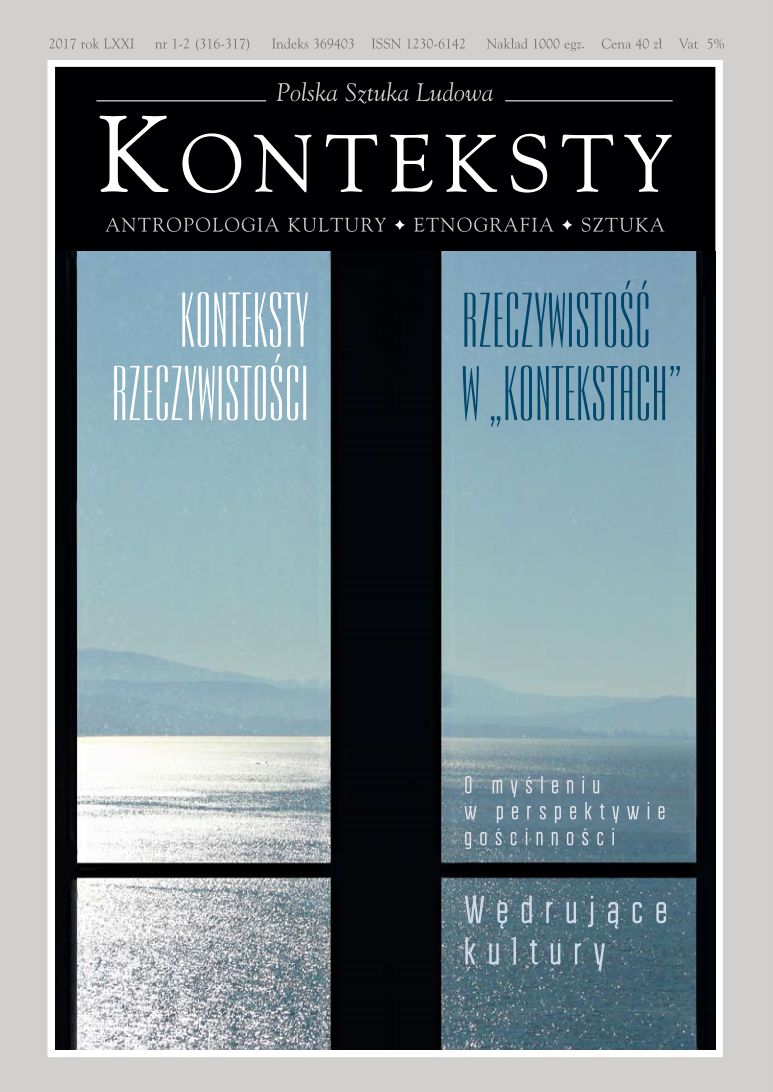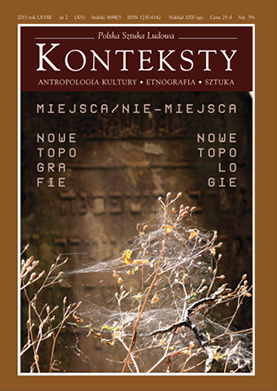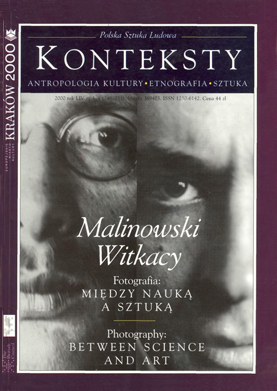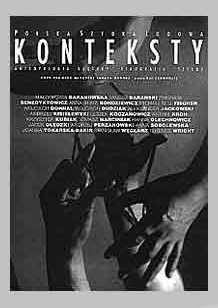Issue 2010/4 (291) - Konteksty

| Zbigniew Benedyktowicz | 3 | |
| *** | ||
| Lech Sokół | 6 | |
| Ewa Korulska | 7 | |
| Aleksander Jackowski | The Institute of Art Seen by an Old Age Pensioner | 8 |
| Stanisław Mossakowski | 10 | |
| Zbigniew Benedyktowicz | 11 | |
| Ludwik Stomma | 15 | |
| *** | ||
| Antoni Kroh, Barbara Magierowa | One Has to Live, or How the Town Population Coped in the Reality of People’s Poland  | 17 |
This time, the authors of Prywatny leksykon współczesnej polszczyzny (in 2010 their files totalled about 13 mln characters) chose from their archive a linguistic phenomenon illustrating the daily concern of town inhabitants with all sorts of material aspects (in the countryside the situation was slightly different, and thus the vocabulary varied). The mass media spoke a language of their own, as did the people, but for obvious reasons both sides maintained mutual relations; this is the reason why the authors cite the language of the street, private conversations and the press of the period. They present examples of a vocabulary concentrated on the household, money, prices, bribes, rationing, dollars and foreign currency tokens. | ||
| Wiesław Szpilka | The Republic of People’s Poland at the Foot of Mt. Giewont  | 32 |
The author recalls the communist era in the Podhale region and analyses the phenomenon of the titular period as well as its myths and symbols. In a comparison with pre-war Zakopane, he ironically and by keeping a certain distance depicts the pettiness and grotesque traits of the communist resort town. | ||
| Ludwik Stomma | Strange, Complex World  | 38 |
The People’s Republic of Poland as a reality brimming with historical and everyday paradoxes – such an image emerges from a personal account by a Polish anthropologist and feuilletonist | ||
| Ludwik Lewin | Beloved Country  | 43 |
In this essay-reminiscence, the author accentuates the unobvious and complicated character of stands and convictions shared by the population of People’s Poland, especially during the early, Stalinist period. Such an approach (which the author – a witness of those years – supports) negates some of the black-and-white historical interpretations written from today’s “objective” point of view. | ||
| Andrzej Dobosz | 45 | |
| Tadeusz Sobolewski | Poland of My Parents  | 49 |
”In 1956 Witold Gombrowicz predicted that once communism in Poland collapses, the Poles will be already changed and never return to their nineteenth-century national imagery. This prophecy pertains to my generation – but not to those of its members who today march in the costumes of the Piłsudskiites or the national democrats. I find both those traditions equally alien. And I much prefer the tradition of Wojtyła, Mazowiecki, Tischner, Kuroń and Michnik. (…) This vision of a martyred nation, associated with the suffering of Christ and bringing freedom to the whole world, has for two hundred years burdened the Polish consciousness in the manner of a phantom. The twentieth-century critics of this tradition – such as Czesław Miłosz – blame it for favouring national idolatry and the creation of a perverse megalomania of suffering and a cult of death. After 1956 the young generation wished to cast off this messianistic burden and to turn towards life. The same goal was pursued by successive Polish generations – the generation of ’68 and the Solidarity generation – in their efforts of curing themselves of the national complex in which an awareness of inferiority gives rise to megalomania” – wrote Tadeusz Sobolewski. | ||
| Marek Nowakowski | My Dictionary of the People’s Republic of Poland fragments  | 52 |
A subjective “dictionary” by a careful observer of the reality of the People’s Republic of Poland. | ||
| Zyta Oryszyn | History of an Illness”, “History of Mourning”, “Black Illumination”, “Madam Frankensztajn" fragments  | 60 |
Fragments of novels by Zyta Oryszyn, originally issued by underground publishing houses. | ||
| Dariusz Czaja | A Hawaiian Dances with Reserve  | 66 |
This text about the singer Violetta Villas, popular in the People’s Republic of Poland, was originally presented as part of the cabaret-art programme of the spoken periodical ”Gadający Pies”. The author traced in Villas’ life and performances ”exotic” motifs transcending the gloomy reality of People’s Poland. | ||
| Marcin Świetlicki | 68 | |
| Karol Modzelewski | Political Grotowski  | 69 |
A recorded statement made by Karol Modzelewski at an international conference: Grotowski. Narrations (Warsaw, 14-15 January 2010) organised by the Institute of Polish Culture at Warsaw University and the Committee of Cultural Studies at the Polish Academy of Sciences. Prof. Modzelewski recalled Grotowski from the period prior to the latter’s involvement in the theatre – the time when Grotowski was active in the Union of Polish Youth. In doing so, author shows Godowsky’s departure from communism and poses questions about the connection between the disappointment caused by the impossibility of altering the communist system and the beginning of the creative path of one of Poland’s greatest theatre directors. | ||
| Adam Michnik, Tadeusz Konwicki | “I’m Considered Contrary” – a Conversation with Tadeusz Konwicki  | 72 |
A record of a meeting between Tadeusz Konwicki and Adam Michnik, which took place in June 2009 while shooting the documentary film What Am I Doing Here? Tadeusz Konwicki (scenario and direction Janusz Anderman, premiere: April 2010). | ||
| Przemysław Kaniecki | The Threatened Word. On the Interpretation of Konwicki’s Works in the People’s Republic of Poland 1970s and 1980s  | 80 |
An attempt at an anthropological interpretation of the situation of the milieu of Polish studies at Warsaw University at the turn of the 1970s. The milieu in question is portrayed as a community (in the meaning borrowed from A. P. Cohen), which in the conditions of a threat to its fundamental value – the word – defends its boundaries. The author accomplished this by, i. e. examining the “badly present” authors and phenomena pertaining to domains affected by censorship. The ensuing reading is based on analyses of selected scientific interpretations of works by Tadeusz Konwicki. | ||
| Walentyna Krupowies | Lithuania of Miłosz, Lithuania of Konwicki. On the Polish Strife with the Provinces  | 99 |
The article analyses the intellectual, spiritual and artistic strife of Miłosz and Konwicki with their birthplaces. The first two of the article’s five parts deal with the path traversed by Miłosz, spanning from rebellion and the rejection of the private homeland as well as certain forms of Polish culture that assumed shape in the Eastern Borderland, the re-evaluation of the poet’s spiritual and intellectual stand during the early stage of his life as an emigre, up to becoming convinced about the value of the home and the “small homeland”. The third fragment of the text shows how Konwicki painstakingly constructed his own cultural lineage. Part four – Time of Cultural Quests – formulates five basic questions around which both authors built the identity discourse of their own private homeland and the Grand Duchy of Lithuania. The last part – Time for Stories – demonstrates how the writings of Miłosz, Konwicki and many other authors create a textual space, in which the Wilno past is outlined as a model for the coexistence of cultures and languages and becomes a model of heterogeneous culture. | ||
| Paweł Sowiński | Against People’s Poland. Glimpses from the Life of the Printers of Forbidden Books 1977-89  | 107 |
This text is an introductory sketch to a presentation of so-called second circulation printing in the People’s Republic of Poland. Maintained in the style of an historical essay, it depicts scenes from the life of underground printers working for the opposition both in Warsaw and in smaller centres. With the assistance of selected examples and generalising commentaries, the author shows certain motivations, stands and experience as well as the conditions of the development and infrastructure of printing. The research was conducted by applying historical methods, and the analysis embraces archival source material from the underground press and reminiscences, including accounts by the participants of the independent publishing movement. Pertinent bibliography has been reduced to historical publications, rarely supplemented with loose observations from other domains. | ||
| Julia Holewińska | Home, Church, Street. Spaces of the Underground Theatre in the 1980s  | 118 |
The author writes about underground theatrical space in Poland in the 1980s. During the martial law period space was outright oppressive: the situation prevailing in the state forced artists to seek new places where they could cultivate art free from the intervention of censorship. Such space proved to be private apartments, churches, parish halls and streets. The text contains copious documentary material but also tries to show the ways in which those “non-theatrical” spaces influenced the performance of the actors, the repertoire, stage motion and the reactions of the public. | ||
| Joanna Olech | The Polish School of Illustrations – 1960s and 1970s  | 127 |
In the wake of the systemic transformation, which took place in Poland in 1989, the whole post-war past of the country became the object of critical assessments. Values, views, predilections, stereotypes, achievements and national sins – all were re-evaluated and verified. As a rule, the balance sheet was pitiful – the civilisational progress of our society, tightly constrained by the “sole correct” ideology, could not be compared to Western standards. Nonetheless, there did exist certain enclaves of social life that today do not provoke expiation and embarrassment; on the contrary, they comprise reservations of freedom, which the ideological control of the state did not reach. The more peripheral and distant from politics the activity of the Poles – the greater the freedom enjoyed by artists. Such a “reservation” was undoubtedly the children’s book market in Poland during the 1960s and 1970s. | ||
| Krzysztof M. Bednarski | Page from a Diary 13 December 1981, Warsaw Sphinx Out of Africa  | 132 |
Three brief texts, which Krzysztof Bednarski added to the photographic documentation of his works from the 1980s, referring to the artist’s individual experiences associated with the communist epoch in Poland. | ||
| Natalia Kaliś | The Wonderful Awareness of Defeat. On “Wstyd” by Jerzy Bereś  | 136 |
The point of departure of this analysis of Jerzy Beres’ Wstyd, realised in 1989 at the Centre of Polish Sculpture in Orońsko, is a comparison of the feeling of shame experienced by the artist in the course of the performance, and the indignity that is an important component of a masochistic spectacle. Such embarrassment is a confirmation of the unsteady position of the subject, his balancing between two simultaneous positions – that of the object and the subject. This situation in the artist’s activity is interpreted as a private ritual of experiencing freedom while being aware of its actual deprivation. | ||
| Wojciech Bałus | The Poetics of People’s Poland in Paintings by the “Wprost” Group and Jurry Zieliński  | 140 |
Painters belonging to the Cracow-based ”Wprost” group and Jerzy Ryszard ”Jurry” Zieliński created two poetics making it possible to take a critical look at the reality of communist Poland. Paintings executed by members of the ”Wprost” group depicted the greyness, poverty and hopelessness of the surrounding world but left a residue of hope, usually rather “insubstantial”. Metonymic daily life merged with moral and religious metaphors. The canvases painted by Jurry were of a sheer dialectical nature and their recipient was compelled to set into motion his aspect-perception (Wittgenstein) in order to decipher their contents – he had to be capable of reading between the lines. | ||
| Łukasz Ronduda | The KwieKulik Workshop of Documentation and Dissemination  | 150 |
The independent institution managed by Zofia Kulik and Przemysław Kwiek in their tiny apartment in the Praga district in Warsaw – “The Workshop of Activity, Documentation and Dissemination” – was a domain of a permanent problematisation of the boundary between the public and private sphere, imposed by the Peoples’ Republic of Poland. The artists tried to define the relations between those spheres not upon the basis of binary opposition but permeation and the creation of their unique “community”. | ||
| Barbara Major | Exhibition “The Home in Photography”  | 153 |
The Home in Photography is the fourth and last show in a series of the ”home” exhibitions featured at the VII International Triennale of Art Sacrum held at the City Gallery in Częstochowa: “Home – the way of existence”. The author-exhibition curator discussed the most prominent recurring motifs. | ||
| *** | ||
| Tomasz Szerszeń | Art, Anthropology and… Cheburashka  | 159 |
The Villa Sovietica project is composed of two equal parts: an exhibition held in Conches and a catalogue combined with a visual essay (Villa Sovietica. Objets Soviétiques: Import – Export, ed. by Alexandra Schussler, photos: Willem Mes and Jonathan Watts, Infolio Editions 2009). The text concentrates on one of the project’s motifs: the creative obliteration of the boundaries between anthropology and art, which leads to an interesting shift within the museological discourse. | ||
| Alexandra Schüssler | Villa Sovietica  | 161 |
The Villa Sovietica exhibition held on 2 October 2009–20 June 2010 at the Ethnographic Museum in Geneva was an attempted presentation and conceptualization of a collection of “Soviet objects”. The text is the opinion of the exhibition curator, who has accepted a dual time perspective: the catalogue text is combined with an “opinion after”, discussing its reception. | ||
| Katarzyna Murawska-Muthesius | Café caricature as the medium of modernity: Michalik’s Den in Kraków  | 167 |
The significance of caricature for the aesthetics of modernity was declared by Baudelaire in mid-nineteenth century Paris, while the uniqueness of the coffeehouse as a hub of modernist literary movement was discussed at large in the context of the turn of the century Vienna. This article is about the symbiotic interaction between these two: the medium of caricature and the socio-cultural institution of the cafe and their joint contribution to the process of fostering modern urban identities in fin-de-siecle Krakow, a self-declared suburb as much of Vienna as of Paris. It examines the affinities between cafe and caricature and it identifies a special type of caricature which, produced in a cafe, serves as a visualisation of a concept, an argument in a debate or a display of skills, rarely entering collectors’ portfolios or cabinets of drawings. Unrecognised so far in art-historical literature, the cafe caricature – ephemeral, fugitive, contingent – better than any other medium fits the definition of modernity as described by Baudelaire. There are at least two ways to approach the interconnectedness of cafe and caricature. One, is to look at this relationship in the context of liberal modernity, identified with experiment, synaesthetic impulse, performativity and subversion. Another way, more political, is to admit that, in spite of the concurrency with rebellion, both cafe and caricature served also as malleable tools of the disciplining of modernity. Both were parading subversion while hiding at the same time their inimical adherence to rituals and formulas, and both were perfectly suited to essentialise and ostracise the Other through the excuse of reforming urban society under the veil of anti-philistine laughter. The text focuses on cafe caricature produced at Michalik’s Den, the most famous bohemian coffeehouse in Krakow, set up in 1895 with its walls covered with caricatures from top to bottom, which has survived not only the interwar years and the German occupation, but also its ‘nationalisation’ in the 1950s. The article claims that the preserved caricatures of Michalik’s Den, provide thus the unique material evidence for examining and defining cafe caricature as a special type of art-making and for its contextualisation within a wider field of pre-Dadaist rebellion against conventions, definitions and boundaries, within the sphere of Polish Fin-de-siecle, as well as for tracing its post-1945 echos in the art of the unrelenting Polish modernist Tadeusz Kantor. | ||
| *** | ||
| Jerzy Sławomir Wasilewski | Transgression and Death, Laughter versus Death  | 184 |
The author is working on a text about comical transgressions in culture, entitled Niepoważność; the published article is a fragment. One of the mourners attending a funeral of an English soldier is the deceased’s best friend, dressed in a bright yellow summer frock and pink knee socks. This costume is connected with a promise made by the two men on the battlefield: of one of them were to perish then the other would dress in this way for the funeral. The ethnologist places the event within a wider cultural context, not satisfied with a psychological explanation. It is precisely the anthropologist who can decipher in assorted ways the symbolic content of the funeral transgression: in an individual case he should perceive despair and rebellion, while a collective act should be interpreted as an expression of the state of death, its acceptance and overcoming. | ||
| Sebastian Borowicz | “Graus oinophoros”. The Phantasmagoria of Death – the Phantasmagoria of the Image  | 191 |
Anus ebria is an image created out of anti-ideas, cliches that violate or distinctly undermine the cultural taboo, just as drunken women, sexual promiscuity or emancipation from the rule of traditionally established norms. As a comic and sneering ”discloser” of norms and principles it becomes one of the most characteristic signs of the ”eschatology of inebriation”. This is not so much an ”old female drunkard” as an ”old rebel”. In its visual and linguistic dimension she assumes the shape of a lascivious old drunk whose vulgar behaviour is a vivid reversal of the natural state of being. | ||
| *** | ||
| Maciej Wiktor Kornobis, Marcin Hinz | We Ask So As to Not Stumble. “Eyes and Lenses” VII | 198 |
| Sławomir Sikora, Krzysztof Kopczyński, Zbigniew Benedyktowicz | Discussion Panel: Document and the Anthropological Film | 201 |













